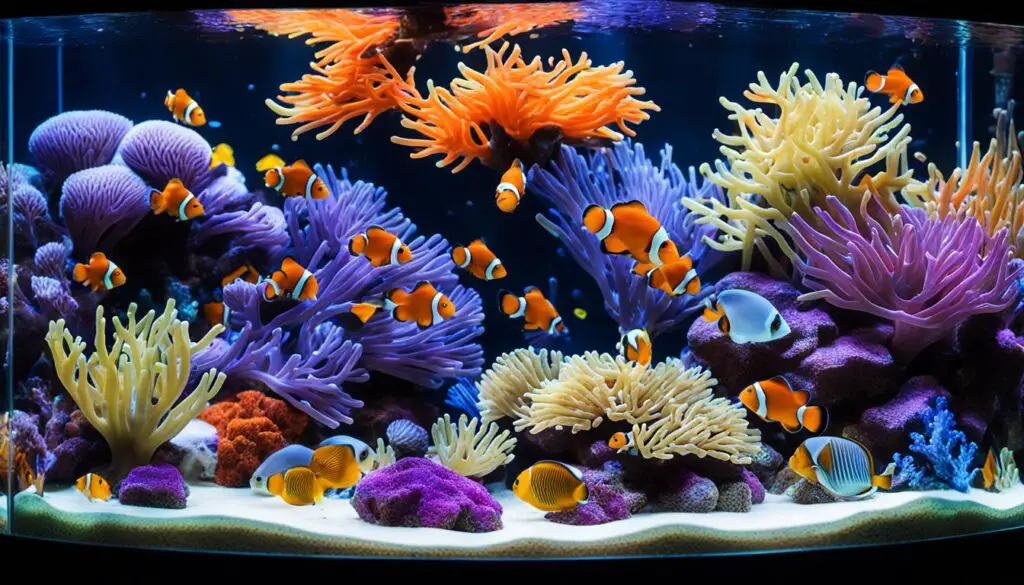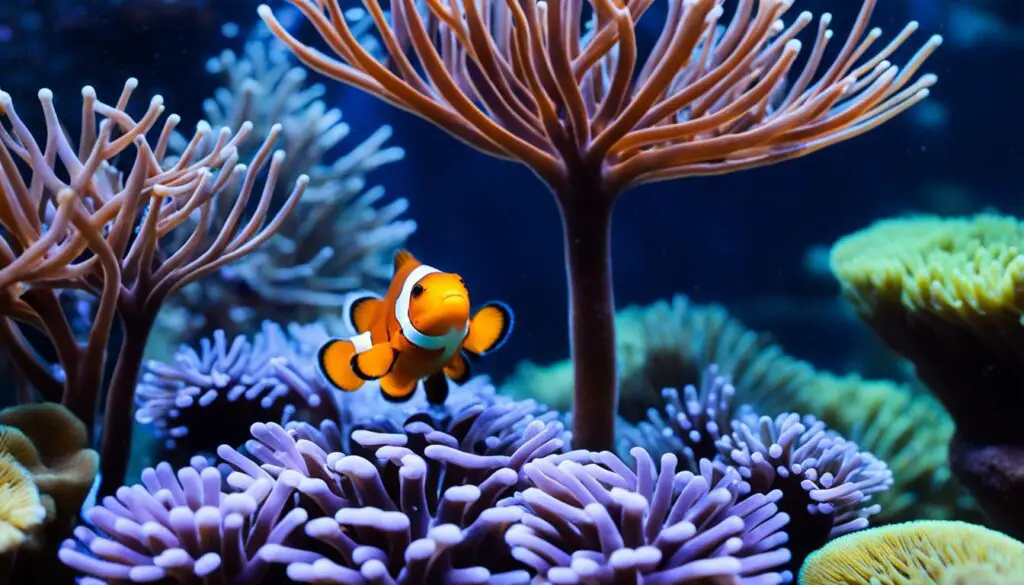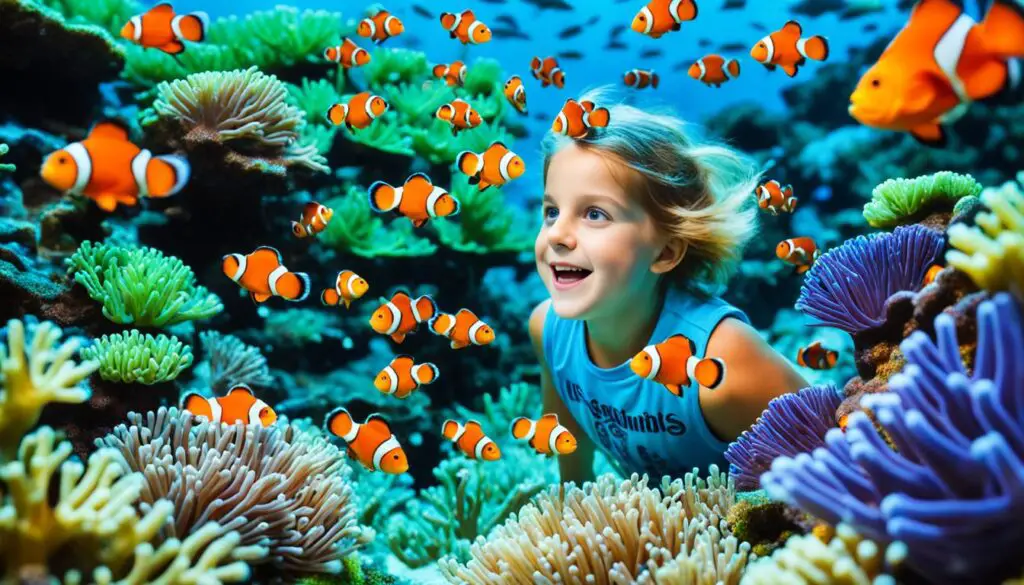Colorful Reef Fish: A Symphony of Colors: Marvel at the Vibrant World of Reef Fish!
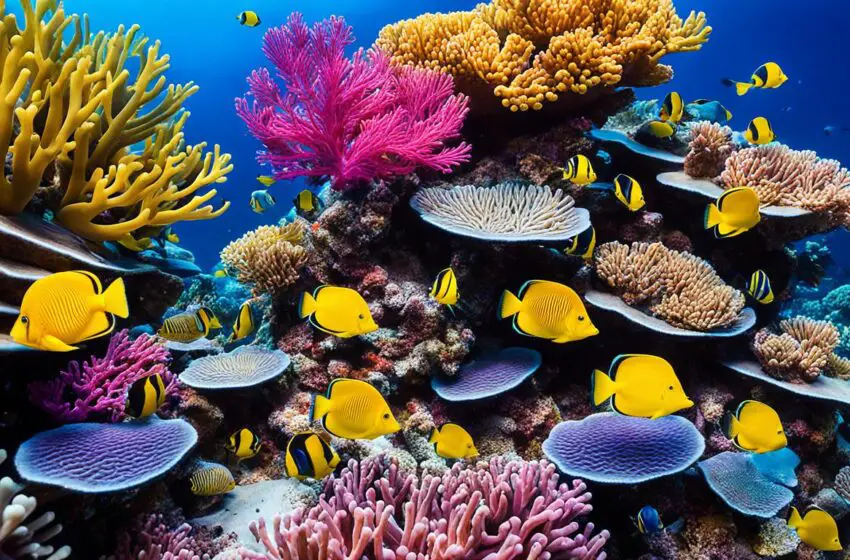
Get ready to be amazed by the stunning world of coral reef fish. Let’s dive deep and witness the amazing variations among species. We will be in awe of the bright colors and unique features of these underwater beings. This journey will focus on the most striking and diverse reef fish that call our oceans home.
- Colorful reef fish add a vibrant splash of colors to coral reefs.
- These underwater creatures have fascinating characteristics that make them unique.
- Coral reefs are home to a diverse array of reef fish species.
- Exploring the colorful world of reef fish is an adventure in itself.
- Appreciating the beauty of reef fish helps us understand and protect their fragile habitats.
Clownfish: The Vibrant Superstars of Coral Reefs
Clownfish, or Amphiprioninae, are the stars of the coral reefs. Their bright orange color and special bond with sea anemones make them stand out. These fish have a slimy cover that shields them from the anemones’ stings. They live near them because they’re safe there.
Clownfish live in groups with a lead female, a breeding male, and helpers. Males help take care of the babies. This kind of fish is all about teamwork and family.
Clownfish have won over many hearts with their flashy orange look. This color helps them blend in with their homes in the ocean. Their homes, sea anemones, get food and nutrients from the clownfish’s activities.
“The bond between clownfish and sea anemones is a great example of nature teamwork. Both the fish and the anemones win, creating a great environment,” says marine biologist Dr. Anna Martinez.
Clownfish act in cool ways within their groups. The big boss female and the breeding male keep their status. Other males help them look after the group and keep their space safe. This setup helps the whole clownfish crew do well together.
These fish became really famous thanks to the movie “Finding Nemo.” The film shows how amazing and loving these tiny creatures are. Now, kids and grown-ups both see clownfish as ocean heroes.
The unique characteristics of clownfish:
- Vibrant orange coloration: Their vivid hues make them instantly recognizable in the coral reefs.
- Symbiotic relationship: Clownfish and sea anemones rely on each other for survival, forming a mutualistic partnership.
- Family-oriented behavior: Clownfish live in small groups led by a dominant female and breeding male, exhibiting cooperative parenting.
Fun fact about clownfish:
The most iconic species of clownfish is the Amphiprion percula, often referred to as “true clownfish.” Its vibrant orange coloration and distinctive black outlines have made it a favorite among divers and aquarium enthusiasts.
Let’s dive deeper into the ocean’s wonders and explore more colorful reef fish that inhabit the coral reefs.
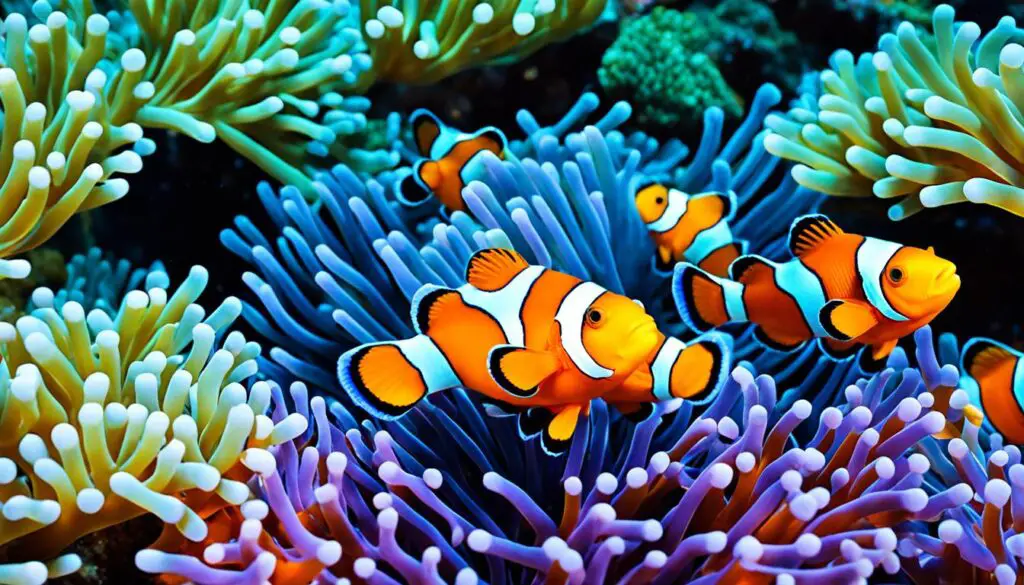
Humphead Wrasse: The Majestic Rockstar of Coral Reefs
The Humphead Wrasse is a real celebrity of the coral reefs. It’s also called the Napoleon fish. Its large size and blue and green colors make it stand out. When you see it swim, it’s like meeting a famous person under the sea.
This fish can live up to 30 years. As it moves through the coral, it shows off its grace and size. The hump on its head makes it look even more majestic.
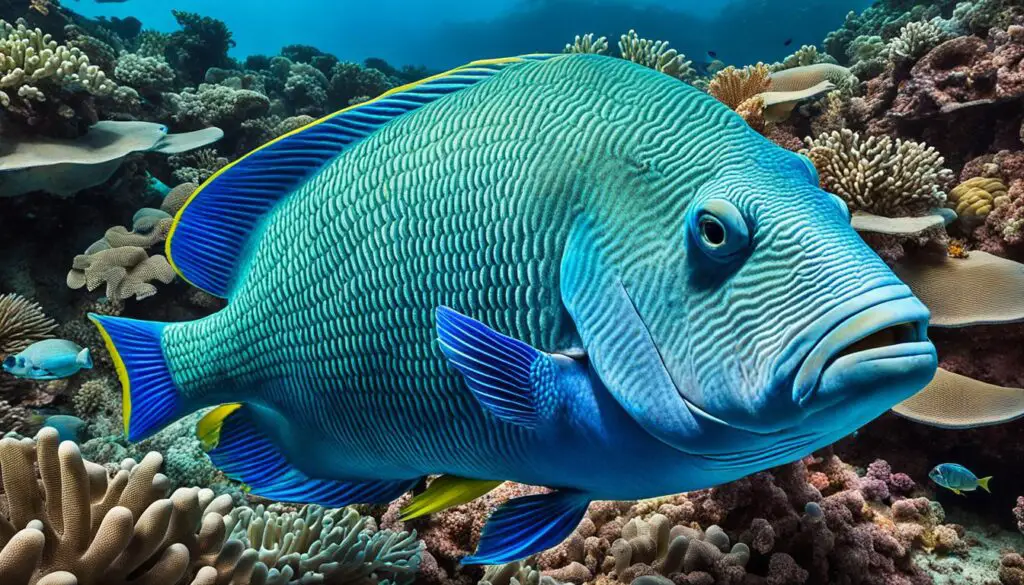
At night, the Humphead Wrasse hides in a special way. It makes a mucus cocoon to blend in with the coral. This keeps it safe while sleeping.
The Humphead Wrasse is a part of the ocean’s beauty. Its bright colors bring life to the coral reef. The fish is a sign of the amazing life under the sea.
The Wonders of the Humphead Wrasse:
- Prominent hump on the forehead
- Vibrant blue and green coloration
- Impressive size
- Camouflage technique for sleep
“The Humphead Wrasse is the epitome of majesty in the coral reef kingdom. Its vibrant colors and distinct features make it a true rockstar of the ocean.” – Marine Biologist
| Characteristic | Description |
|---|---|
| Prominent hump on the forehead | A distinguishing feature that contributes to its majestic appearance |
| Vibrant blue and green coloration | The colors accentuate its presence and add to the allure of the coral reefs |
| Impressive size | A large fish that demands attention and respect in its habitat |
| Camouflage technique for sleep | Secreting a mucus cocoon allows it to blend seamlessly into its surroundings, ensuring peaceful rest |
Regal Blue Tang: The Reigning Royalty of the Ocean
The Regal Blue Tang, or Paracanthurus hepatus, rules the ocean with its stunning looks. Its body is a brilliant blue, and its tail shines yellow. This makes it stand out in coral reefs.
Regal Blue Tangs have tiny hidden spines for self-defense. These spines help keep predators away. It’s amazing how nature protects these beautiful fish.
Regal Blue Tangs are amazing swimmers. They move gracefully through the coral. Their vibrant colors make the reefs even more beautiful.
These fish bring extra beauty to the ocean. They liven up the coral reefs with their diverse colors. Meeting a Regal Blue Tang is a truly enchanting experience under the sea.
The Vibrant Colors of the Regal Blue Tang
The regal blue tang is famous for its blue body and yellow tail. These colors help it shine in the ocean.
“The regal blue tang’s vibrant coloration is a result of specialized chromatophores in its skin that produce and reflect light to create such a vivid display. It’s truly a natural marvel.” – Marine Biologist Dr. Rebecca Johnson
The blue body is not just pretty. It also scares off predators. They see the bright blue and stay away.
The yellow tail looks great against the blue. It adds to the tang’s royal look. These colors make the Regal Blue Tang stunning.
| Species | Coloration | Distinctive Features |
|---|---|---|
| Regal Blue Tang | Vibrant blue body, yellow tail | Hidden spines for defense, excellent swimmers |
Leafy Sea Dragon: The Master of Disguise
The Leafy Sea Dragon, known as Phycodurus eques, is a master of disguise. It blends perfectly into seagrass and kelp. Its leaf-like parts let it become nearly invisible, merging with the sea plants.
Watching them move in the wild, I couldn’t look away. Their flow matches the moving seagrass. It feels like a dance, echoing through the ocean.
But their looks and dance aren’t the only amazing things about them. Their way of having babies is also unique. Unlike most underwater animals, it’s the dad who carries the eggs. This shows nature’s surprising roles.
The Leafy Sea Dragon truly shows marine life’s magic. Its hidden body parts, perfect hiding, and unusual parenting make it special. They reflect the ocean’s vast beauty and mystery.
FAQ
Are clownfish aggressive towards other fish in the coral reef?
No, clownfish are not mean to other fish in the coral reef. They focus on staying close to sea anemones and guard their home.
How long can a Humphead Wrasse live?
The Humphead Wrasse, or Napoleon fish, can live for up to 30 years. This long life lets them see the coral reef change over time.
What is the defense mechanism of Regal Blue Tang?
The Regal Blue Tang has tiny spines that it hides in its scales for protection. These spines scare off dangerous animals, keeping the fish safe.
How do Leafy Sea Dragons camouflage in their surroundings?
Leafy Sea Dragons look like leaves, making them hard to see in their home of seagrass and kelp. Their disguise helps them sneak up on prey unseen.

